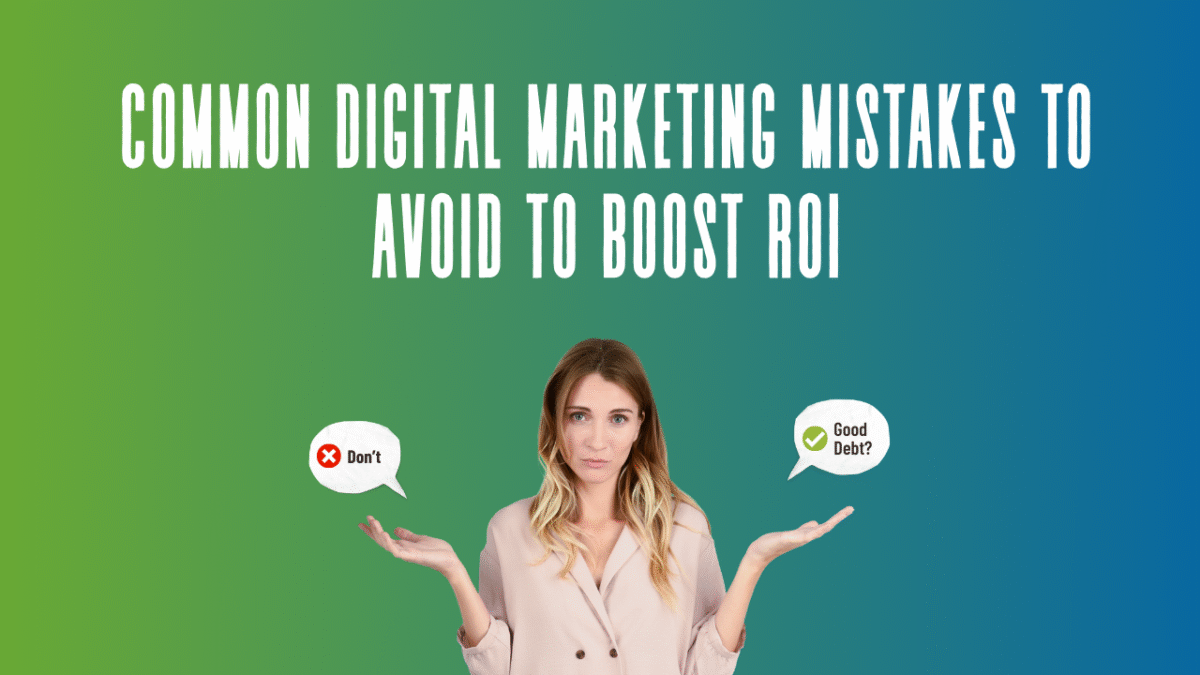Imagine that an eCommerce mid-brand has increased its ad spend by 40% during Q1 anticipating increased sales. But what it gets instead is the opposite of growth: its CPA is doubled, email opens dwindle, and web traffic stagnates. Why? No one on the team understands.
In today’s blog, we’ll walk you through some of the most common digital marketing mistakes that brands make and how to avoid them. Let’s get into what you must stop doing and what you need to start doing to achieve maximum success with your digital marketing strategies.
1. Skipping Clear Campaign Objectives
Running campaigns without clear goals is like trying to drive with a blindfold on. You end up wasting your budget, misreading data, and missing out on real opportunities. Here are some common traps to watch out for:
- Spending money on clicks without tracking actual conversions
- Focusing on likes or impressions when you really want is a conversion
- Overlooking specific objectives for each channel (like awareness versus conversion)
How to Set SMART Digital Marketing Goals?
You can avoid these pitfalls by setting goals that are:
- Specific (for example, “Generate 200 qualified leads each month”)
- Measurable (so you can track them through forms, calls, or demo sign-ups)
- Achievable (based on your budget and past performance)
- Relevant (aligned with your revenue, brand awareness, or retention goals)
- Time-bound (with weekly, monthly, or quarterly checkpoints)
By defining clear metrics from the start, you can steer your campaigns effectively, allocate your budget wisely, and truly measure your impact.
2. Overlooking SEO Foundations
SEO forms the backbone of your digital presence. Here are some common SEO mistakes to avoid:
- Duplicate content that hurts your keyword relevance
- Misconfigured meta tags and headings
- Slow-loading pages that drive users away and hurt your rankings
How to Avoid SEO Mistakes?
Keep your visibility intact by maximizing your SEO efforts through:
- Conducting thorough site audits
- Aligning your keywords with what users are actually searching for
- Optimizing for page speed, mobile responsiveness, and secure protocols (like HTTPS)
A digital marketing strategy that supports SEO ensures your campaigns work harder and last longer, even after your ad budgets run out.
3. Not Engaging on Social Media
Most brands use their social channels as a broadcast tool by posting content. That’s a wasted chance. Inadequate engagement results in low coverage, lost insights, and negative brand perception.
You can get more from your social channels by:
- Responding to messages and comments quickly
- Engaging in discussions within your industry
- Creating interactive content such as live sessions, Q&As, and polls
Active engagement raises awareness, fosters credibility, and deepens brand loyalty, which is why it is of utmost importance to engage with others on social media.
4. Marketing Without Audience Insight
Another common problem is developing content and campaigns without understanding the people you’re addressing. Without customer insight, initiatives are generic and disappointing, and therefore, they neither resonate nor convert.
How to Know Your Audience?
Create solid personas through:
- Collecting demographic and behavioral information
- Conversing with customers and sales teams
- Getting clear on problems, needs, objections, and decision-making drivers
With precise audience targeting, your marketing becomes more effective, personalized, and measurable.
5. Inconsistent Positioning of Brand
When your branding and voice shift across channels, it creates disjointed experiences. Inconsistency erodes credibility, weakens recall, and causes confusion.
To guarantee that your messaging is cohesive throughout, you can ensure alignment by:
- Maintaining unified branding through logos, fonts, colors
- Following a defined brand voice across content and ads
- Centralizing key messages to maintain identity
- Regularly auditing all touchpoints for consistency
A reliable brand creates trust, loyalty, and recall, which is an asset in today’s digital marketing services market.
6. Outdated Content
Did you know that even evergreen content requires maintenance? This is because even the strongest content gets old and out of date. Search engines prefer current information, and readers will understand outdated guidance before you do. So then how to keep your content fresh and relevant? You can be current by:
- Developing an editorial calendar
- Refreshing stats, examples, and case studies
- Repurposing content into alternative formats (e.g., infographics, video)
- Reinvigorating top-level positions with new words or images
Newness increases participation and informs search engines that your website is up to date and trustworthy.
7. Overcomplicating Digital Marketing Strategies
Some companies make things too complicated, which hurts their ROI. Adding more tools, channels, or trendy strategies doesn’t always mean better results. Too much complexity can waste resources and make it harder to manage everything effectively.
How to Stay Focused on Efforts?
Simplify for clarity by:
- Identifying core-performing channels and formats
- Piloting new tools before scaling them
- Automating simple tasks, directing human effort towards strategy
- Measuring progress against your top goals
A streamlined marketing plan tends to be faster, more scalable, and more powerful.
8. Incomplete Conversion-Driven Calls to Action
CTAs can make or break your results. Weak calls to action are one of the most underutilized conversion-killers. Even great content is a failure without a clear next step for the reader.
What you need are CTAs that convert. Make sure each piece of content has:
- A noticeable and goal-aligned CTA
- Action-oriented copy, such as “Get My Guide” or “Book a Free Review”
- Placement across several high-engagement spots
Also, don’t forget to A/B test variations to discover what works for your website. Maximised CTAs turn passive readers into active users and enable you to quantify the return on each asset.
9. Depending on Hit-or-Miss Budget Planning
Spending money on ads without thoughtful planning results in expensive customer acquisition and erratic performance. Without optimization, you’re at the mercy of algorithms. What you need to do is plan your budget smartly. Budget strategically by:
- Beginning with test bursts targeting high-intent audiences
- Monitoring performance KPIs and optimizing spend
- Spreading your budget across search, social, email, and content
- Scaling what performs well and trimming what doesn’t
Budget management fueled by intelligence significantly boosts ROI.
10. Not Tracking or Adjusting Based on Data
When you’re not measuring outcomes, you’re flying blind. Without data, it’s impossible to know what works or how to allocate resources effectively.
How to Make Data Your Compass?
Become data-driven by:
- Setting up performance dashboards
- Monitoring KPIs every week and getting into analytics
- Conducting quarterly reviews with insights and next steps
- Testing new methods based on what’s working
Data-driven decision-making translates to smarter choices and improved ROI in the long term.
Redefine Your Digital Strategy
Digital marketing can really help your business grow—but only if it’s done the right way. Avoiding these ten common mistakes can turn your efforts from guessing into a smart strategy. When you set clear goals, use the right channels, stay consistent, and track results, you save money and get faster success. By skipping these common errors, you create a strong foundation for real growth and a resilient brand.
Take some time today to look at your current marketing. Are there any gaps, overlaps, or missed chances? Use these best practices to make your next marketing push smart, simple, and effective.If you want expert help, look for our digital marketing services. We help brands from goal-setting to campaign execution, creating powerful strategies that deliver results.

